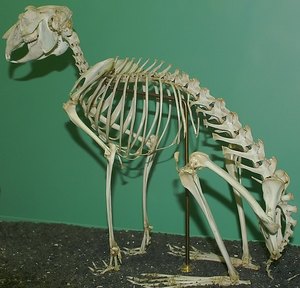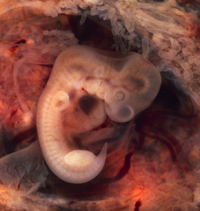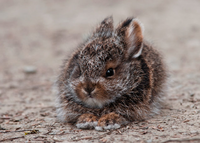Difference between revisions of "Arctic Hare"
(→Key Stage 1: Created page + wrote text for key stage 1 section.) |
m (→Key Stage 2: Some subheadings were wrong) |
||
| (5 intermediate revisions by the same user not shown) | |||
| Line 2: | Line 2: | ||
===Meaning=== | ===Meaning=== | ||
[[File:ArcticHare1.PNG|right|300px|thumb|A picture of an [[arctic hare]].]] | [[File:ArcticHare1.PNG|right|300px|thumb|A picture of an [[arctic hare]].]] | ||
| − | An | + | An '''arctic hare''' is a small [[animal]] with 4 legs and short, pointy ears. |
| − | ===About | + | ===About Arctic Hares=== |
| − | : An | + | : An '''arctic hare''' has smaller ears than a [[rabbit]]. |
| − | : The | + | : The '''arctic hare''' can run up to 60 kilometers (40 miles) per hour. |
===Examples=== | ===Examples=== | ||
| Line 13: | Line 13: | ||
|[[File:ArcticHare3.PNG|center|300px]] | |[[File:ArcticHare3.PNG|center|300px]] | ||
|- | |- | ||
| − | | style="height:20px; width:300px; text-align:center;" |This is a picture of an [[arctic hare]]. | + | | style="height:20px; width:300px; text-align:center;" |This is a picture of an '''arctic hare''' jumping. |
| − | | style="height:20px; width: | + | | style="height:20px; width:300px; text-align:center;" |This is a picture of an '''arctic hare''' eating snow. |
| + | |} | ||
| + | |||
| + | ==Key Stage 2== | ||
| + | ===Meaning=== | ||
| + | An '''arctic hare''' is a small burrowing [[mammal]] with 4 legs and short, pointy ears. | ||
| + | |||
| + | ===About Arctic Hares=== | ||
| + | : As a [[mammal]] '''arctic hares''': | ||
| + | :*Have a [[backbone]]. | ||
| + | :*Feed their babies with [[milk]]. | ||
| + | : '''Arctic hares''' are found in Arctic tundra habitat. | ||
| + | : The '''arctic hare''' can run up to 60 kilometers (40 miles) per hour. | ||
| + | : '''Artic hares''' dig holes in the ground or snow to sleep in. | ||
| + | : A young hare is called a leveret. | ||
| + | |||
| + | {| class="wikitable" | ||
| + | |- | ||
| + | |[[File:ArcticHare4-Skeleton.PNG|center|300px]] | ||
| + | |- | ||
| + | | style="height:20px; width:300px; text-align:center;" |An '''arctic hare's''' [[Skeletal System|skeleton]] showing its [[backbone]]. | ||
| + | |} | ||
| + | |||
| + | ===Lifecycle of an Arctic Hare=== | ||
| + | {| class="wikitable" | ||
| + | |'''Foetus''' | ||
| + | |'''Young''' | ||
| + | |'''Adult''' | ||
| + | |- | ||
| + | |[[File:Embryo2.png|center|200px]] | ||
| + | |[[File:ArcticHare5-Young.PNG|center|200px]] | ||
| + | |[[File:ArcticHare6.PNG|center|200px]] | ||
| + | |- | ||
| + | | style="height:20px; width:200px; text-align:center;" |An '''arctic hare''' starts its life inside the mother getting its food through the umbilical cord. | ||
| + | | style="height:20px; width:200px; text-align:center;" |When an '''arctic hare''' has been born it cannot eat so it gets milk from its mother to survive. This is a young arctic hare '''leveret'''. | ||
| + | | style="height:20px; width:200px; text-align:center;" |An adult '''arctic hare''' is mature and can have it's own [[offspring]]. | ||
| + | |} | ||
| + | |||
| + | ===Adaptations of Arctic Hares=== | ||
| + | {| class="wikitable" | ||
| + | |- | ||
| + | | style="height:20px; width:200px; text-align:center;" |'''Adaptation''' | ||
| + | | style="height:20px; width:400px; text-align:center;" |'''Purpose''' | ||
| + | |- | ||
| + | | style="height:20px; width:200px; text-align:center;" |Thick coat of fur | ||
| + | | style="height:20px; width:400px; text-align:center;" |To help the '''arctic hare''' keep itself warm in its cold climate. | ||
| + | |- | ||
| + | | style="height:20px; width:200px; text-align:center;" |Short ears and short legs | ||
| + | | style="height:20px; width:400px; text-align:center;" |To prevent it from losing too much temperature from its legs or ears. | ||
| + | |- | ||
| + | | style="height:20px; width:200px; text-align:center;" |Snow white fur | ||
| + | | style="height:20px; width:400px; text-align:center;" |To camouflage them from potential predators, such as the [[arctic fox]]. | ||
| + | |- | ||
| + | | style="height:20px; width:200px; text-align:center;" |Extra body fat | ||
| + | | style="height:20px; width:400px; text-align:center;" |Also to help the '''arctic hare''' keep itself warm. | ||
|} | |} | ||
Latest revision as of 14:33, 12 August 2019
Contents
Key Stage 1
Meaning

A picture of an arctic hare.
An arctic hare is a small animal with 4 legs and short, pointy ears.
About Arctic Hares
- An arctic hare has smaller ears than a rabbit.
- The arctic hare can run up to 60 kilometers (40 miles) per hour.
Examples
| This is a picture of an arctic hare jumping. | This is a picture of an arctic hare eating snow. |
Key Stage 2
Meaning
An arctic hare is a small burrowing mammal with 4 legs and short, pointy ears.
About Arctic Hares
- As a mammal arctic hares:
- Arctic hares are found in Arctic tundra habitat.
- The arctic hare can run up to 60 kilometers (40 miles) per hour.
- Artic hares dig holes in the ground or snow to sleep in.
- A young hare is called a leveret.
| An arctic hare's skeleton showing its backbone. |
Lifecycle of an Arctic Hare
| Foetus | Young | Adult |
| An arctic hare starts its life inside the mother getting its food through the umbilical cord. | When an arctic hare has been born it cannot eat so it gets milk from its mother to survive. This is a young arctic hare leveret. | An adult arctic hare is mature and can have it's own offspring. |
Adaptations of Arctic Hares
| Adaptation | Purpose |
| Thick coat of fur | To help the arctic hare keep itself warm in its cold climate. |
| Short ears and short legs | To prevent it from losing too much temperature from its legs or ears. |
| Snow white fur | To camouflage them from potential predators, such as the arctic fox. |
| Extra body fat | Also to help the arctic hare keep itself warm. |





